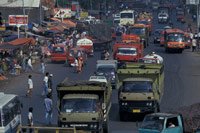http://web.worldbank.org/WBSITE/EXTERNAL/NEWS/0,,contentMDK:21102761~pagePK:34370~piPK:34424~theSitePK:4607,00.html
October 5, 2006—Road traffic injuries get plenty of local attention where and when they occur. Traffic accidents are vivid reminders of the harm machines and their users can cause if there is a mishap.
Globally, carnage on roads is on the scale of an epidemic. Traffic fatalities and casualties are so high––the daily equivalent of ten survivor-less jumbo jet crashes––it is surprising how little international attention the problem has garnered. According to the most recent estimates, road traffic accidents kill 1.2 million victims worldwide and injure 50 million each year.
Low-income and middle-income countries account for well over three quarters of the casualties, affecting the most vulnerable groups, including pedestrians and other road users. As a global burden of disease, measurements indicate that in the coming two decades, road traffic crashes will jump well ahead of malaria and tuberculosis, and for certain population sub-groups, will only be surpassed by HIV/AIDS.
Road traffic accidents are already the fourth leading cause of death for 15–59 years olds in low and middle income countries. The economic cost of the slaughter for all age groups is estimated at between $65 and $100 billion per year. This compares with total overseas bilateral aid in 2005 that amounted to approximately $106 billion.
Casualties Rising in Poor Countries

A child, mother and father unprotected and in harms way.
Photo: © Sam Zimmerman, TUDTR
One bit of good news in this grim picture is that road traffic casualties have declined and continue to abate in richer countries. However, as indicated above, the statistics from poor countries show an upward trend that is projected to persist well into the coming years.
Latin America and the Caribbean has the highest road traffic deaths per capita, losing approximately 122,000 lives each year. Oscar Arias Sanchez, president of Costa Rica and 1987 Nobel Peace Prize winner, likens the magnitude of the situation to the internecine struggles that claimed many lives 20 years ago in Central America. “Times have changed….We face a danger that not only kills people but lulls us into an unconscious silence: violence on the roads,” he wrote recently in an op-ed in the Washington Post.
East Asia and the Pacific region have the highest numbers of deaths: 188,000 in 2000, expected to rise to 337,000 per year in 2020, with China bearing the brunt. South Asia has the highest expected projected growth—144 percent in road traffic fatalities by 2020, with India accounting for the bulk of them.
Sub-Saharan Africa is projected to register an 80 percent increase by 2020––the same as predicted for East Asia and Pacific. The Middle East and North Africa, Latin America and the Caribbean, and Europe and Central Asia are expected to experience significant increases as well. Only high-income countries are predicted to record a decline in car crash casualties.
Organizing to Prevent Road Accidents
This depressing portrait is a source of serious international concern and various organizations are working in tandem to invest in ways to prevent and reverse the tragedy of road traffic casualties. The United Nations has passed two resolutions endorsing the findings of the World Report on Road Traffic Injury Prevention, launched on World Health Day 2004 by the World Bank and the World Health Organizations.

Unsafe by all means: pedestrians risk their lives
In response, the World Bank created the Global Road Safety Facility to generate the resources required to implement the recommendations of the World Report, at the global, regional and country levels. Among its activities, the Facility supports the U.N. Global Road Safety Collaboration by funding its initiatives.
Representatives of the Facility also recently participated in the Latin American and Caribbean Road Safety Stakeholders Forum in San Jose, Costa Rica, which attracted numerous organizations that are focusing on the problem, among them the Commission for Global Road Safety, headed by former NATO Secretary General Lord Robertson, a road crash survivor and a leading advocate for road safety.
Raising Awareness and Preventing Injuries
The Commission has launched a safer roads campaign predicated on the conviction that investment in improved road infrastructure and safety must become part of poverty reduction measures taken to achieve the Millennium Development Goals. The Commission recommends that governments in low and middle income countries adopt their own national road traffic casualty reduction targets to encourage sustainability.
Country Ownership of Solutions Essential
The Bank’s focus via the Global Road Safety Facility is on strengthening country management capacity to improve road safety results in the context of global and regional initiatives. “This is a mutually supportive set of relationships,” says Lead Road Safety Specialist Anthony Bliss in the Transport and Urban Development Department at the Bank. “It speaks to the Bank’s global development mission as a practitioner of multi-sectoral instruments to bring about poverty alleviation.”
Such instruments have already been applied at the country level through a stand-alone, 2nd generation road safety project in Vietnam. This kind of project combines short-term solutions by addressing physical infrastructure deficiencies with medium and long-term institutional responses by progressively building up road safety management system capacity. "Safe, quality-assured infrastructure simply does not happen in the absence of country-ownership of these solutions," says Bliss.
The demand for road safety initiatives from the Bank’s client countries is high, many having long ago recognized that the economic and moral costs of road deaths and injuries is no longer acceptable.
At the country level, the Bank is also preparing a new transport sector strategy that places a high priority on road safety. At the global, regional, and country levels, the Bank is taking a leadership role through the Global Road Facility. This has never been more apparent than at the Costa Rica forum, where President Sanchez led participants in signing the Declaration of San Jose, urging the nations of the region to commit the necessary resources in order to stop the growing epidemic of road deaths and injuries.
October 5, 2006—Road traffic injuries get plenty of local attention where and when they occur. Traffic accidents are vivid reminders of the harm machines and their users can cause if there is a mishap.
Globally, carnage on roads is on the scale of an epidemic. Traffic fatalities and casualties are so high––the daily equivalent of ten survivor-less jumbo jet crashes––it is surprising how little international attention the problem has garnered. According to the most recent estimates, road traffic accidents kill 1.2 million victims worldwide and injure 50 million each year.
Low-income and middle-income countries account for well over three quarters of the casualties, affecting the most vulnerable groups, including pedestrians and other road users. As a global burden of disease, measurements indicate that in the coming two decades, road traffic crashes will jump well ahead of malaria and tuberculosis, and for certain population sub-groups, will only be surpassed by HIV/AIDS.
Road traffic accidents are already the fourth leading cause of death for 15–59 years olds in low and middle income countries. The economic cost of the slaughter for all age groups is estimated at between $65 and $100 billion per year. This compares with total overseas bilateral aid in 2005 that amounted to approximately $106 billion.
Casualties Rising in Poor Countries

Photo: © Sam Zimmerman, TUDTR
One bit of good news in this grim picture is that road traffic casualties have declined and continue to abate in richer countries. However, as indicated above, the statistics from poor countries show an upward trend that is projected to persist well into the coming years.
Latin America and the Caribbean has the highest road traffic deaths per capita, losing approximately 122,000 lives each year. Oscar Arias Sanchez, president of Costa Rica and 1987 Nobel Peace Prize winner, likens the magnitude of the situation to the internecine struggles that claimed many lives 20 years ago in Central America. “Times have changed….We face a danger that not only kills people but lulls us into an unconscious silence: violence on the roads,” he wrote recently in an op-ed in the Washington Post.
East Asia and the Pacific region have the highest numbers of deaths: 188,000 in 2000, expected to rise to 337,000 per year in 2020, with China bearing the brunt. South Asia has the highest expected projected growth—144 percent in road traffic fatalities by 2020, with India accounting for the bulk of them.
Sub-Saharan Africa is projected to register an 80 percent increase by 2020––the same as predicted for East Asia and Pacific. The Middle East and North Africa, Latin America and the Caribbean, and Europe and Central Asia are expected to experience significant increases as well. Only high-income countries are predicted to record a decline in car crash casualties.
Organizing to Prevent Road Accidents
This depressing portrait is a source of serious international concern and various organizations are working in tandem to invest in ways to prevent and reverse the tragedy of road traffic casualties. The United Nations has passed two resolutions endorsing the findings of the World Report on Road Traffic Injury Prevention, launched on World Health Day 2004 by the World Bank and the World Health Organizations.

Unsafe by all means: pedestrians risk their lives
In response, the World Bank created the Global Road Safety Facility to generate the resources required to implement the recommendations of the World Report, at the global, regional and country levels. Among its activities, the Facility supports the U.N. Global Road Safety Collaboration by funding its initiatives.
Representatives of the Facility also recently participated in the Latin American and Caribbean Road Safety Stakeholders Forum in San Jose, Costa Rica, which attracted numerous organizations that are focusing on the problem, among them the Commission for Global Road Safety, headed by former NATO Secretary General Lord Robertson, a road crash survivor and a leading advocate for road safety.
Raising Awareness and Preventing Injuries
The Commission has launched a safer roads campaign predicated on the conviction that investment in improved road infrastructure and safety must become part of poverty reduction measures taken to achieve the Millennium Development Goals. The Commission recommends that governments in low and middle income countries adopt their own national road traffic casualty reduction targets to encourage sustainability.
Country Ownership of Solutions Essential
The Bank’s focus via the Global Road Safety Facility is on strengthening country management capacity to improve road safety results in the context of global and regional initiatives. “This is a mutually supportive set of relationships,” says Lead Road Safety Specialist Anthony Bliss in the Transport and Urban Development Department at the Bank. “It speaks to the Bank’s global development mission as a practitioner of multi-sectoral instruments to bring about poverty alleviation.”
Such instruments have already been applied at the country level through a stand-alone, 2nd generation road safety project in Vietnam. This kind of project combines short-term solutions by addressing physical infrastructure deficiencies with medium and long-term institutional responses by progressively building up road safety management system capacity. "Safe, quality-assured infrastructure simply does not happen in the absence of country-ownership of these solutions," says Bliss.
The demand for road safety initiatives from the Bank’s client countries is high, many having long ago recognized that the economic and moral costs of road deaths and injuries is no longer acceptable.
At the country level, the Bank is also preparing a new transport sector strategy that places a high priority on road safety. At the global, regional, and country levels, the Bank is taking a leadership role through the Global Road Facility. This has never been more apparent than at the Costa Rica forum, where President Sanchez led participants in signing the Declaration of San Jose, urging the nations of the region to commit the necessary resources in order to stop the growing epidemic of road deaths and injuries.
No comments:
Post a Comment